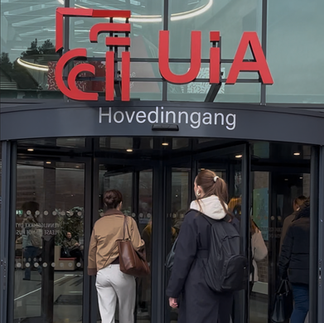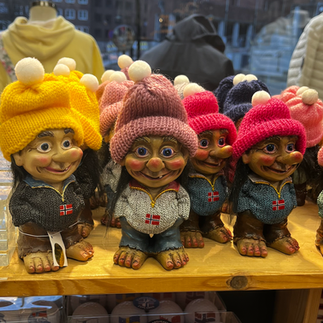In the Land of Fjords: My Time as a Visiting Researcher in Norway
- Joseph Martínez
- Dec 6, 2024
- 3 min read
I was selected to participate in the International Student Exchange Program (ISEP) funded by the U.S. Air Force Office of Scientific Research (AFOSR). This program is designed to connect AFOSR-funded teams internationally to deepen collaboration and allowed me to spend a month in Norway, collaborating with faculty at the University of Agder (UiA) in Kristiansand. It was a unique blend of travel, breathtaking scenery, and interdisciplinary research—an experience that left a lasting impression on me. Here are some of the key lessons I brought back from this unforgettable journey...

1. Ask for it or apply for it; just do it.
When I was notified of my acceptance, I immediately thought of one of the best pieces of advice my supervisor ever shared, paraphrasing: “Always ask for what you want or apply for what catches your attention.”
Impostor syndrome often builds mental barriers, convincing us we aren’t good enough or qualified, and we give up before even trying. I’ll admit, there were moments when I doubted whether I’d be accepted into this program. Procrastination and self-doubt were constant ghosts in my head, whispering that I wasn’t ready. But the truth is, you’ll never know what’s possible unless you try.
I’m so glad I didn’t give in to those doubts. If I hadn’t applied, I wouldn’t have had the chance to discover how UiA’s innovative AI research interconnects with our own, missing out on the impactful collaborations that took place during the program. Looking back, I can confidently say that the pain of regret is always far worse than the fear of taking action.
My advice? Always go for it. You never know what opportunities might come your way.
2. Conversations spark ideas, but collaboration builds knowledge.
During this project, I worked closely with a historian and a computer science professor to explore the cultural identities shaping Norwegian society.
Our research aimed to uncover what people associate with being “Norwegian,” using newspaper archives from 1946 to the present as our primary source.
Having a historian, Dr. Apostolos Spanos, on the team was invaluable. He brought nuanced perspectives to the table, providing historical context that shaped our understanding of which cultural identities to include and prioritize. For instance, while religion is a significant factor in shaping beliefs and attitudes, Norway’s historical ties to various religions added layers of complexity to our discussions.
This experience highlighted a critical lesson: interdisciplinary collaboration challenges you in ways that simple conversations never can. While brainstorming across fields is exciting, doing the actual work together takes things to a whole new level. It pushes you to acknowledge gaps in your expertise, communicate effectively across disciplines, and grow professionally and personally.
Through this process, I learned to simplify complex concepts from my training in engineering and modeling & simulation, reduce jargon, and connect ideas in ways I hadn’t considered before. It was humbling yet rewarding, forcing me to confront areas where my understanding was incomplete and strengthening my knowledge as a result. True collaboration makes you better—it challenges your ego and enhances your perspective.
3. Exploring Norway’s diverse and rich culture.
Our research revealed fascinating insights about how Norway’s cultural identities have evolved. For example, newspaper archives highlighted how Norwegians often associate their ethnicity with other Scandinavian groups—Swedish, Danish, or Finnish. Regarding religion, discussions frequently revolved around Islam, Catholicism, and Christianity, reflecting Norway’s mixed religious landscape.
But this diversity wasn’t just a research finding but something I experienced firsthand. Walking through Oslo, I saw the positive influence that migrants from Arab and East African countries had on Norwegian society. At UiA, the campus itself reflected this cultural richness, blending stunning natural surroundings with a vibrant, diverse community. The cultural exchanges I witnessed made me appreciate how history and migration interconnect to shape a nation’s identity.
Bonus: Building confidence through interdisciplinary research.
My experience at The Storymodelers has equipped me with the tools and confidence to take on this challenge: traveling to a new country, leading a research project, and collaborating with faculty from different fields. Our lab’s focus on interdisciplinary work and creative problem-solving prepared me to navigate the complexities of this experience and give my best.
By embracing a collaborative mindset, I learned how to work seamlessly with peers from different disciplines, generate innovative ideas, and push the boundaries of what I thought was possible. This journey reaffirmed the importance of stepping out of my comfort zone and trusting in my ability to adapt and grow.
Final Reflections
This experience was one of the highlights of my academic journey. From stimulating research discussions over coffee to breathtaking hikes in Norway’s serene landscapes, every moment was a treasure. I am incredibly grateful for this opportunity and the lessons it taught me. I would gladly repeat it, whether for the research, the culture, or the friendships I built along the way.
Here are more pictures!!













Comments